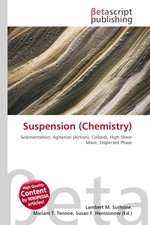Suspension (Chemistry)
Lambert M. Surhone, Miriam T. Timpledon, Susan F. Marseken
бумажная книга
High Quality Content by WIKIPEDIA articles! In chemistry, a suspension is a heterogeneous fluid containing solid particles that are sufficiently large for sedimentation. Usually they must be larger than 1 micrometer. The internal phase (solid) is dispersed throughout the external phase (fluid) through mechanical agitation, with the use of certain excipients or suspending agents. Unlike colloids, suspensions will eventually settle. An example of a suspension would be sand in water. The suspended particles are visible under a microscope and will settle over time if left undisturbed. This distinguishes a suspension from a colloid in which the suspended particles are smaller and do not settle. Colloids and suspensions are different from a solution, in which the dissolved substance (solute) does not exist as a solid and solvent and solute two are homogeneously mixed. A suspension of liquid droplets or fine solid particles in a gas is called an aerosol or particulate. In the atmosphere these consist of fine dust and soot particles, sea salt, biogenic and volcanogenic sulfates, nitrates, and cloud droplets.
Данное издание не является оригинальным. Книга печатается по технологии принт-он-деманд после получения заказа.


